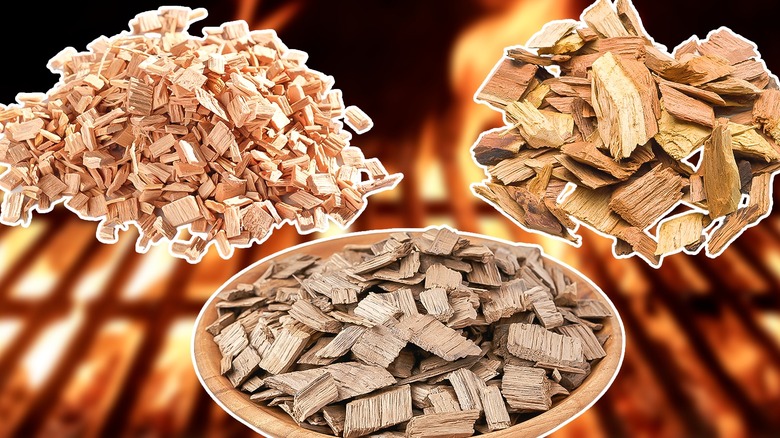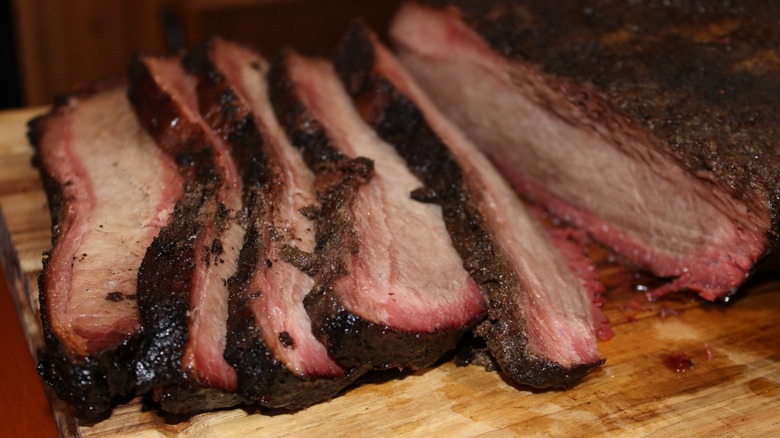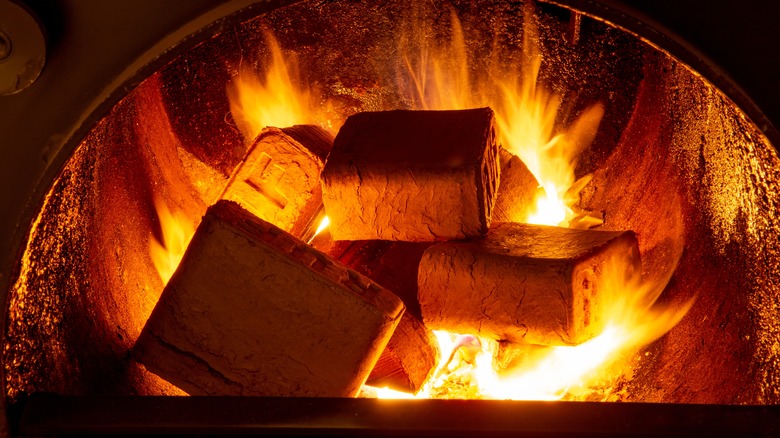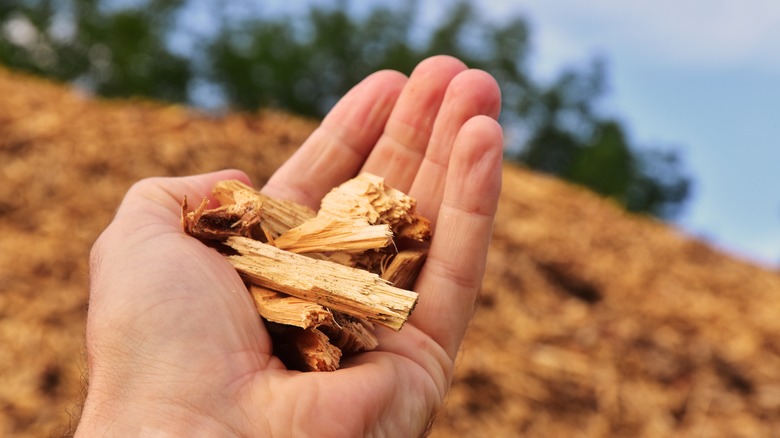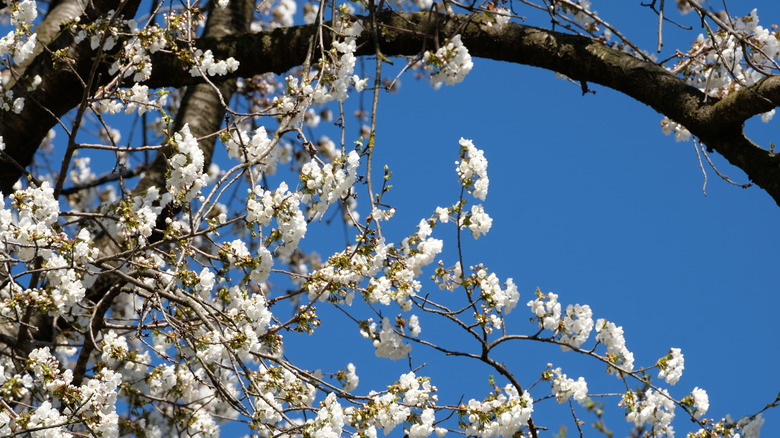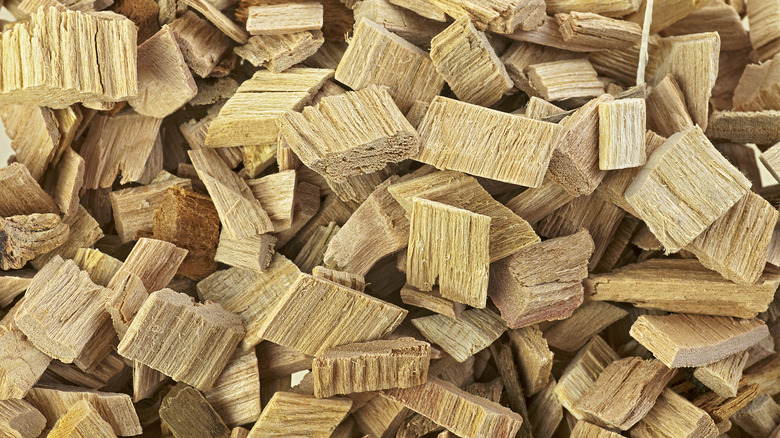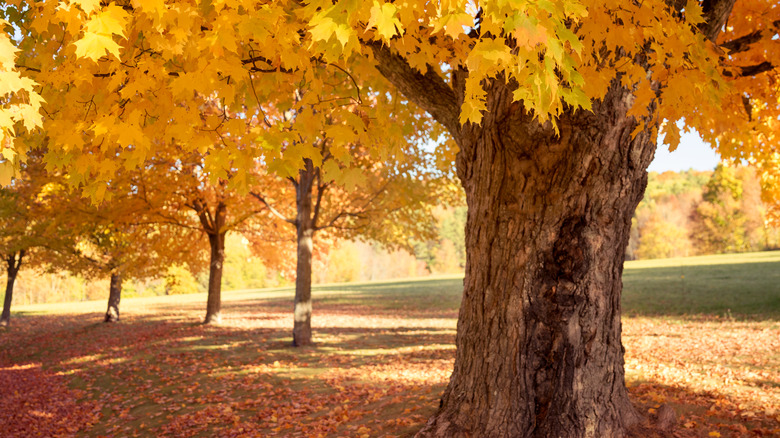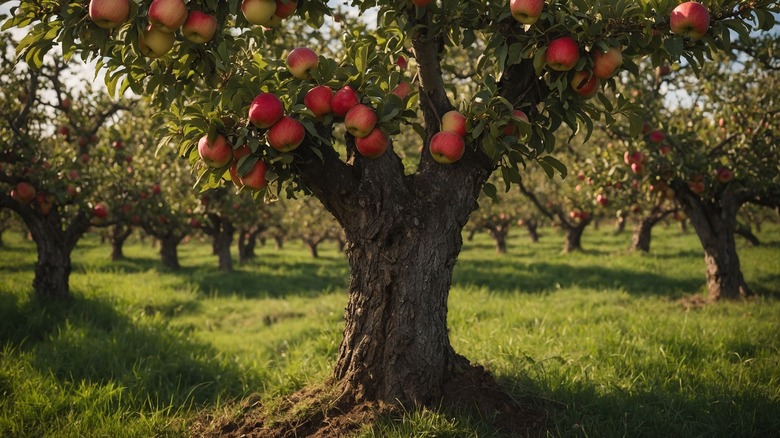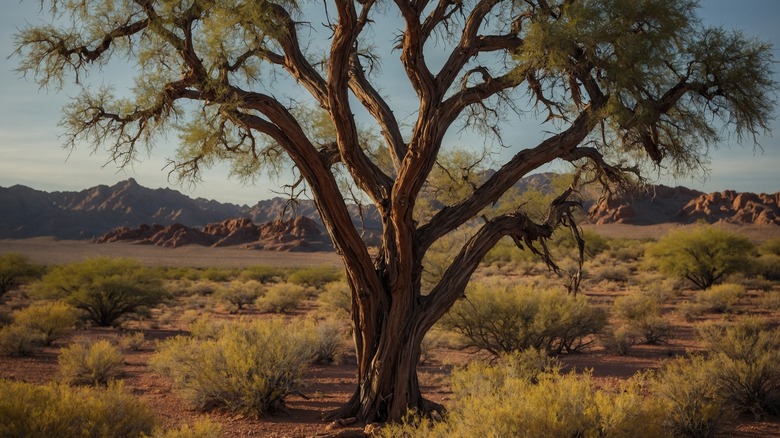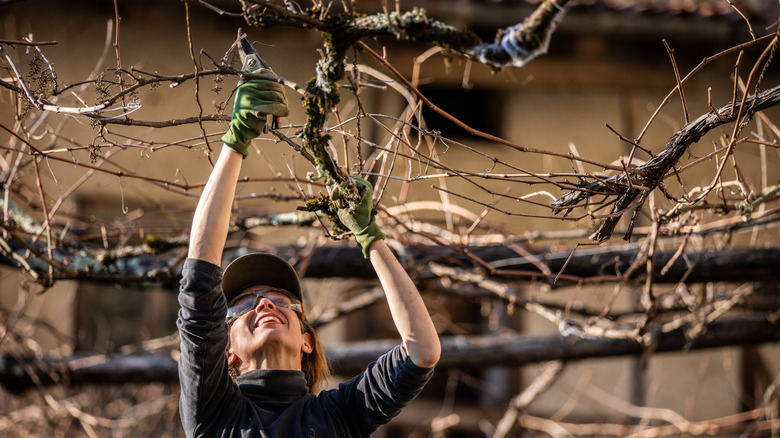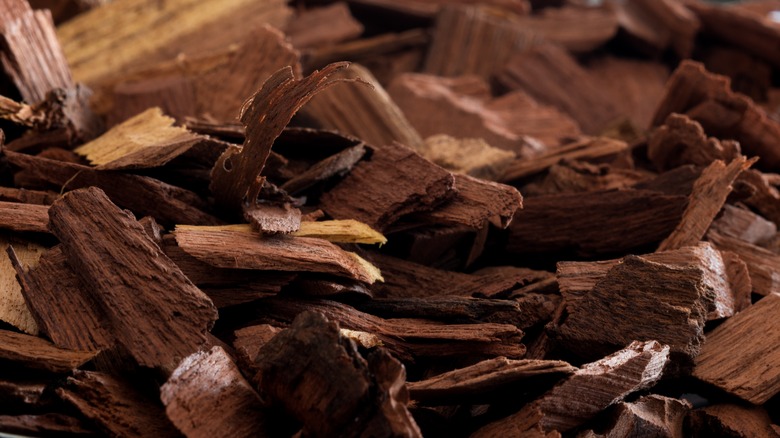The Best Types Of Wood To Use For Smoking And Grilling
The aroma of smoke defines outdoors cooking. Sure, you can cook on just charcoal or on an electric grill and get a tasty meal. Your food will turn out fine, but whatever you make will taste pretty much like food prepared indoors, except you get to make it in a nicer setting. But to make your outdoors cooking projects smell and taste like real products of live fire cooking, you need that special something that only real wood smoke can deliver. As Leroy Hite, an expert griller and CEO of Cutting Edge Firewood, put it, "Wood is an ingredient, not just a heat source."
So if you think of the wood for your smoker or grill as an ingredient in your finished dishes, you need to choose it intentionally. But which wood to choose? Most of us have heard of several types used for smoking, such as hickory, but what distinguishes them and how do you work with them? To help unravel the mysteries of smoking and grilling with wood, we've asked Hite and four other experts — fourth-generation pitmaster Barrett Black of The Original Black's BBQ in Texas, Jay Craddick, executive chef at Humble Baron in Shelbyville Tennessee, Tyler Fenton, chef at BATA in Tucson, Arizona, and award-winning pitmaster and Food Network star Erica Blaire Roby – to share their secrets and best tips for cooking with wood.
Post oak
Oak is among the best-known woods for smoking, but, as your plant nerd friends can tell you, oak trees form a huge family – over 500 oak species occur around the world, and the U.S. alone has 90 native oak species. And while they have a lot of common features, they can vary widely in a number of ways, from leaf shape to habitat. Most critically for our purposes, they can differ too in how they behave in the grill or smoker.
Barrett Black has a clear favorite. "My go-to is Texas post oak. Always has been, always will be. It is what my great grandfather started with in 1932 and what we still use today at The Original Black's BBQ," he said. "What I love about post oak is its mild, smoky flavor that never overpowers the meat, it just gets better the longer it burns." Its versatility, he added also makes it indispensable. "Whether you're searing a steak over blazing coals or going low and slow with a brisket, post oak has you covered," he said. And for Black, post oak also adds a special sense of place to his cooking. "Without Texas post oak, Texas BBQ would not be the same," he said.
White oak
Other types of oak also make great wood for smoking and grilling. Among these Leroy Hite recommends white oak. "Great heat and subtle smoky flavor. Great all-around wood," he said. The other experts also recommended oak in general as a useful all-around wood with a pleasant flavor. "This should be a staple in every grilling household," Erica Blaire Roby said. "Oak is easy to use and can be used for both smoking and used as a heat source for grilling."
Because oaks are dense hardwoods and they can burn low and slow, which, combined with their agreeable aroma, gives them a definite advantage for long smoking projects. "When smoking a whole hog, I use oak because its medium flavor profile perfectly complements the meat," Jay Craddick said. Tyler Fenton is a fan of oak for the same reasons. "We opted for oak because the smoke is more delicate," he said. "Mesquite is a great grilling wood, but because we utilize the hearth for long smoke projects, we found that oak gives ingredients a more delicate flavor."
Hickory
Hickory is often the first wood that comes to mind when we think about fuel for our smokers or grills, and it's no wonder: Many of us grew up associating it with smoke-flavored snacks, such as barbecue-flavored potato chips, nuts, and jerky. So in our minds, the smell and taste of smoked food is that of hickory.
The long-ago choice to designate hickory the flavoring of choice for smoky snacks was likely no coincidence. "Hickory wood packs a powerful flavor punch," Leroy Hite said. And besides being deeply flavorful, it's economical. "Hickory is not only flavorful but also affordable. It's perfect for a tighter budget," Erica Blaire Roby said. Its powerful flavor allows it make an impact even with quick-cooking meats. "Grilling typically involves higher heat and faster cooking, so stronger woods like hickory work well," Jay Craddick said. Because of its strong flavor profile, however, it's best with beef and other boldly flavored meats that can stand up to its distinctive aroma.
Cherry
We love the sweet flavor and aroma of cherries in desserts (especially if they're topped with cherry-flavored whipped cream using cherry pits) and in the occasional sweet sauce for game or poultry. But the wood of the cherry tree can also contribute a welcome sweetness to your feasts. "[Cherry is] the queen of flavorful smoke and robust color," Erica Blaire Roby said. "Cherry wood is divinely fragrant and goes hand in hand with pork dishes and beef roasts." Barrett Black concurs. "Cherry wood is another favorite of mine," he said. "What's great about cherry is the mild, fruity smoke flavor it gives off, but also the color. When you smoke with cherry, it leaves a beautiful reddish hue on the outside of the meat, which makes your barbecue look as good as it tastes."
The sweet, delicate aroma of cherry wood makes it a great match for more delicate proteins. "I favor cherry and apple wood for smoking seafood, especially lobster, as they enhance the natural sweetness without overwhelming the flavor," Jay Craddick said. Roby warns, however, that cherry's distinctive flavor profile isn't a great match for everything. "Too much cherry wood can overpower the savory flavor notes of a great beef cut," she said.
Pecan
While the nuts of the pecan tree boast a gentle, buttery flavor, the wood makes its presence known in the smoker. So if you're aiming for a bold, smoky aroma to your meat, pecan is a good option to consider. "For thick cuts of meat, I prefer hickory and pecan due to the rich, smoky, robust taste they impart," Jay Craddick said. Barbecue lovers have described the flavor of pecan-smoked food as reminiscent of that of hickory without the bitter notes hickory can have.
In short, pecan wood can work in the same contexts hickory can. But according to Leroy Hite, its flavor also allows it to combine with other woods, enabling to add even more layers of flavor. "Incredible heat, subtle nutty flavor and mixes well with other woods. A classic BBQ wood," he said. When you work with pecan, however, be aware that it burns quickly, which can be a big advantage in some cases but one that requires extra attention from the pit master. "If you're using something lighter like pecan or applewood, it'll catch fire quicker, but you might find yourself adding more logs more often to keep the heat consistent," Barrett Black advised.
Maple
We're seeing a pattern here: Many of the trees that produce our favorite sweets also make great wood for smoking and grilling. Another of these is maple. The same tree that provides the tasty glaze for your grilled salmon or chicken can also imbue your meal with a sweet, smoky aroma." "If you're looking to experiment, I'd suggest giving maple a try," Barrett Black said. "It's a lighter, sweeter wood that doesn't overpower the meat, and after a long smoke, it'll leave behind a subtle sweetness that's pretty unique. Maple pairs nicely with pork or chicken, where a little sweetness complements the flavors."
The other experts agree. "Maple is a rockstar wood for lighter meats and quick grilling meals," Erica Blaire Roby said. Leroy Hite also sings the praises of maple, which he says "gives mild, sweet flavor to food" and is "excellent with poultry and lamb." Its gentle flavor, however, means it's not the right pick for more boldly flavored meats and cuts. "It will not give a big smoky flavor for bigger cuts of meat or long cooks," Roby said.
Applewood
The sweet-tangy flavor of apples is a big reason many of us love autumn. And if you like to use apple juice in your glazes or barbecue sauce, you'll love the sweet, fruity flavor of applewood smoke. It not only adds wonderful flavor, but according to Erica Blaire Roby, is easy to work with, even if you're a novice griller or smoker. "Applewood is fantastic if you're just starting out," Roby said. "It's mild and forgiving on all meats."
Applewood, traditionally sourced from trees too old to bear fruit, produces fragrant smoke that echoes the aroma of apples. And like the fruit, the wood itself is sweet — it contains a large proportion of sugar, which caramelizes on the surfaces of grilled or smoked foods, adding an extra layer of flavor. Roby recommends applewood for a beginner-friendly smoked chuck roast to be sliced for tacos, but it's also good with any meat that would go well with an apple glaze or garnish, such as whole chicken, pork loins, or hams.
Mesquite
For many foodies, the word mesquite instantly brings to mind Texas barbecue. Not only is the tree native to Texas (and thus easy for local pit masters to source), but, like many iconic Texas flavors, mesquite has a big personality. "Mesquite burns fast and hot, with a bold, distinctive flavor that you'll notice right away," Barrett Black said. "It's perfect for quick-cooking things like steaks, where you want that signature smoky punch without overdoing it."
If left unchecked, big personalities can easily overwhelm any room they enter, and, for that reason, Black said, cooks should exercise restraint when working with mesquite — a little goes a long way. "Mesquite can get a little intense if you smoke with it for hours," Black said. "Too much mesquite, and you'll end up with bitterness, and a lot of folks say it gives them heartburn. But for grilling, where you've got high heat and short cook times, mesquite is your best bet."
Acacia
Experienced grillers and smokers, along with curious eaters, may wonder if the old smokehouse standbys such as oak and hickory are the only choices out there. Not that anything is wrong with our old favorites, of course, but sometimes it's nice to change things up and try something new.
And while not all wood types are suitable (or even safe) for use in the grill or smoker, intrepid cooks can find lesser-known varieties of wood that work surprisingly well for cooking. This is another area in which it pays to ask experts for their advice. "I can recommend our Savanna heat (acacia) wood for long cooks and overnight cooks," Leroy Hite said. "The wood is so dense, it holds heat and fire for hours and is part of the mesquite family, so the smoke imparts a nice, slightly nutty flavor in whatever you are cooking." It has a flavor reminiscent mesquite, but a bit milder. So if you want a deliciously different option for your next long project, such as a flavorful slow-smoked brisket (which is a good marker to test the quality of a barbecue restaurant), look no further.
Grapevine cuttings
Another fruity wood that can contribute flavorful smoke to your next outdoors meal comes not from a tree, but from a vine. Thick, woody cuttings from grapevines produce large clouds of smoke. And while this smoke smells tart and pungent, if grapevine cuttings are used sparingly, they lend a mild, delicate smokiness that goes well with most meats.
Because grapevines produce such thick smoke, however, their flavor can easily overwhelm food, turning it bitter. To avoid this, some cooks recommend using small quantities of grapevine cuttings to supplement other types of wood for grilling or smoking. Another way to avoid overkill is to reserve grapevine cuttings for quick-cooking meats that won't require prolonged exposure to its smoke, like a tasty quick-grilled chicken dish. Yet another strategy to enhance their flavor is to soak grapevine chips in beer, wine, or tea for about 20 minutes before they're used for cooking. Not all cooks may enjoy working with such dense, strongly scented smoke, but if you live near a grape-growing area and can acquire vine clippings easily, they might be worth a try.
Bonus tips: Do's and don'ts for sourcing wood for cooking
Few experiences bring us closer to our primitive roots than cooking over an open fire with real wood. But just because our pre-literate ancestors knew how to find wood, start and maintain a fire, and hunt for and cook their own meat doesn't mean these are easy tasks for modern humans. Contrary to what you may believe, you can't chuck just any bunch of logs or twigs into your smoker and get good — or even edible — results.
"If you grab a log from the yard, chances are that is has rot, mildew, and moisture," Leroy Hite warned. "Wet wood has to burn the moisture out of it before it generates heat and will create an acrid, grey smoke that will make your food taste awful." Barrett Black offered additional tips. "Feel the weight of the wood. A good, dense piece of wood will feel solid in your hands. If it's light, hollow, or cracking apart, that's a sign it has started to rot. Rotten or brittle wood won't burn evenly, and it can leave unpleasant, inconsistent flavors in your food. A heavy log, on the other hand, will burn longer and give you that steady, clean heat we're after."
In addition, some wood types are firm no-go's for cooking. "Avoid using evergreens because they are a soft wood and contain a lot of resin and will make your food taste piney and bitter," Hite said. "Always make sure your wood is free of any pesticides or chemicals," Black warned. "The last thing you want is chemically treated wood on your barbecue pit."
